Understanding Macular Edema: Causes, Treatment, and Prevention
Macular Edema: Understanding, Treatment, and Prevention
Macular edema occurs when fluid accumulates in the macula (a small but crucial part of the retina responsible for central vision). This build-up of fluid can lead to swelling, distorting the macula and impairing vision. The macula is essential for tasks that require sharp, detailed vision, such as reading, driving, and recognizing faces.

What are the Causes?
- Eye Damage: Accidentally or otherwise, damage can occur within the eye itself and lead to vision-impairing problems. This damage must be attended immediately in order to restore clear sight.
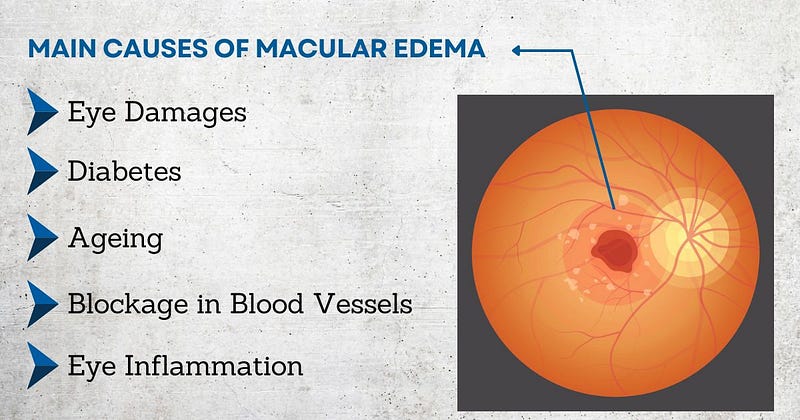
- Diabetes Woes: Diabetics can often suffer from diabetic eye damage that prevents their vision from working as it should. Occasionally this could mean blurry or non-functional lenses or problems with vision related to diabetic retinopathy.
- As we age, the parts of our eyes can weaken or wear away and reduce our vision.
- Blockage in Your Blood Vessels: Blood vessels act like roadways for blood to travel along, so if they become blocked it could result in issues inside of your eyes.
- Eye Inflammation: Just like other parts of your body, eyes can also become inflamed and cause significant vision impairment.
Symptoms
- Blurry Vision: Things you look at may seem unclear or fuzzy, like trying to see through a misty window.
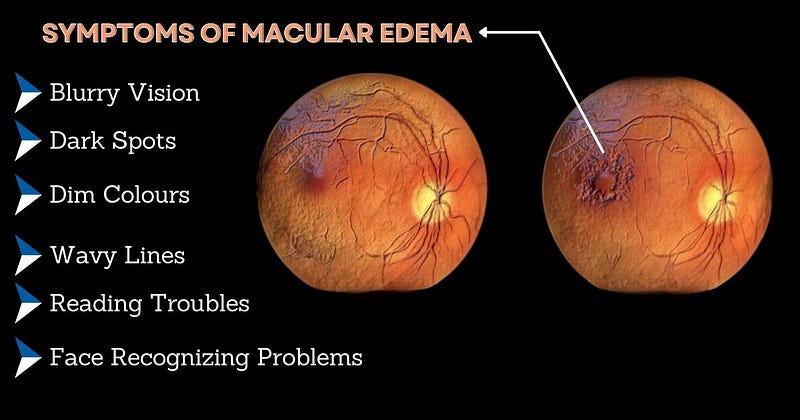
- Dim Colors: Colors might not appear as bright or vibrant as they used to; they may look faded or dull.
- Reading Troubles: Reading small print or focusing on words can become difficult, making it hard to enjoy books or read signs.
- Wavy Lines: When you see straight lines, like those in a book or on a grid, they might appear bent or wavy.
- Dark Spots: You might notice dark or empty spots in your vision, like missing pieces in a puzzle.
- Trouble Recognizing Faces: It can become challenging to recognize people’s faces, especially in detail.
Diagnosing Macular Edema
Prompt diagnosis is essential for effective treatment. Ophthalmologists employ several methods to diagnose it:
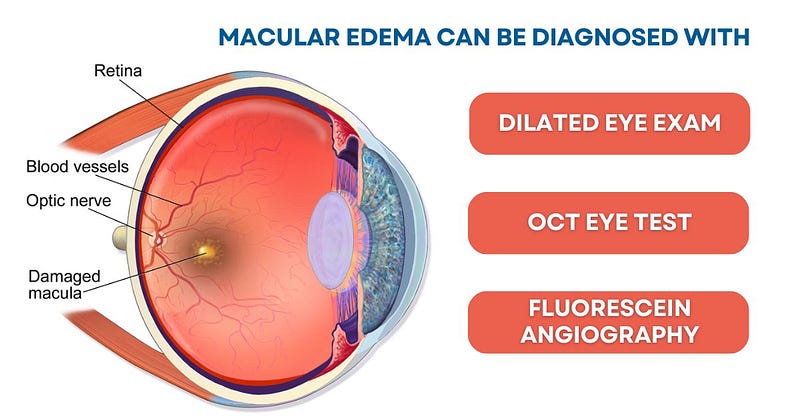
- Dilated Eye Exam: The eye specialist uses eye drops to dilate the pupil and examines the retina for signs of swelling or fluid accumulation.
- Optical Coherence Tomography (OCT): This test is a non-invasive imaging test. It provides high-resolution images of the retina to see if anything’s wrong.
- Fluorescein Angiography: This test involves injecting a fluorescent dye into a vein in your arm. Then photos of the retina are captured when the dye circulates. It helps identifying blood vessel abnormalities and leakage.
Treatment Options
The treatment depends on its underlying cause and severity. Here are some common treatment options:
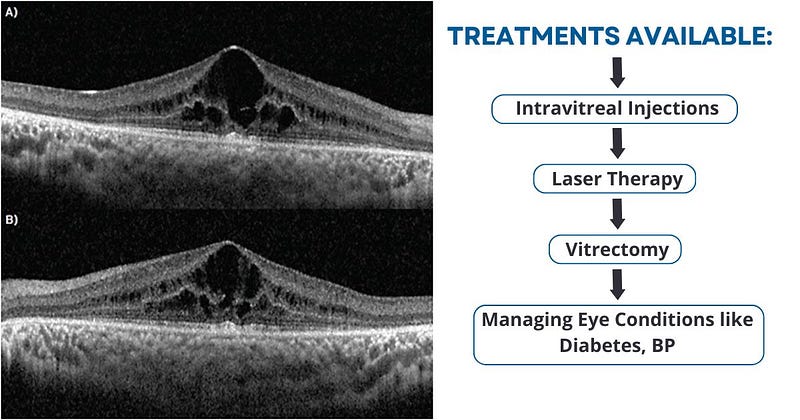
- Intravitreal Injections: Medications, such as anti-VEGF drugs or corticosteroids, can be injected directly into the eye to reduce inflammation and fluid accumulation.
- Laser Therapy: Laser treatment, known as photocoagulation, may be used to seal leaking blood vessels in the retina.
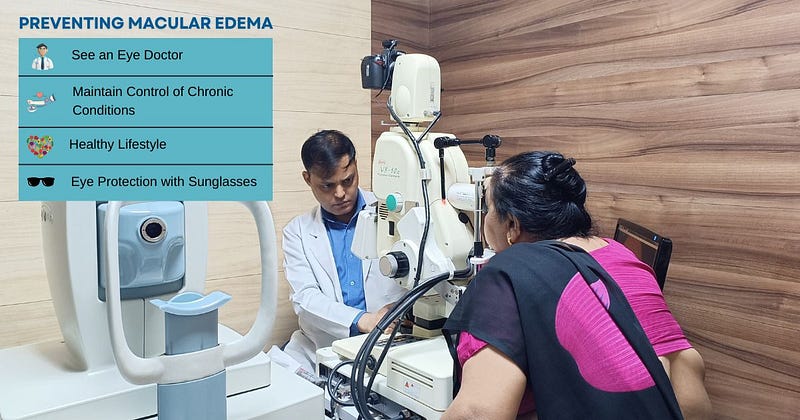
- Vitrectomy: When necessary, vitrectomy can be performed to extract vitreous gel and replace it with saline solution.
- Manage Underlying Conditions: In cases associated with diabetes or high blood pressure, managing these conditions effectively is key to avoiding further damage to vision.
Preventing Macular Edema: Tips for Maintaining Healthy Eyes
Prevention plays a significant role in maintaining eye health. Here are some strategies to reduce the risk:
- See an Eye Doctor: Just like it’s a good idea to see a doctor if you’re experiencing a cold Regular eye exams can assist in identifying issues early and often to catch symptoms before they result in discomfort. A regular visit to your eye doctor can detect problems before you are aware of their presence.
- Maintain Control of Chronic Conditions: If you have a long-term medical issue such as high blood pressure or diabetes cooperating closely with your physician to control these conditions is vital to your overall eye health. It can also help reduce the risk of complications associated with vision. This also helps to provide overall health benefits for your eyes.
- The importance of choosing a healthy lifestyle: A balanced diet with plenty of fruit and vegetables, taking part in regular physical activity, and quitting smoking cigarettes are all good for eye health and general health.
- Make sure your eyes are protected: Use sunglasses designed to block the sun’s harmful rays will ensure your eyes are protected during sunny days. glasses that protect your eyes for sports that involve flying objects could prevent eye injuries that are serious from occurring.
Age-Related Macular Degeneration vs. Macular Edema: Key Differences


Intravitreal Injections: A Breakthrough in Macular Edema Treatment
Intravitreal injections are like special shots, but not the kind that hurt. These shots go right into your eye, but don’t worry, it’s done by experts like Dr. Rajeev Jain who make sure you don’t feel pain.
Now, here’s the magic: These injections carry medicine that can help fix the problem inside your eye. They target the place where the fluid is building up and causing the blurriness.
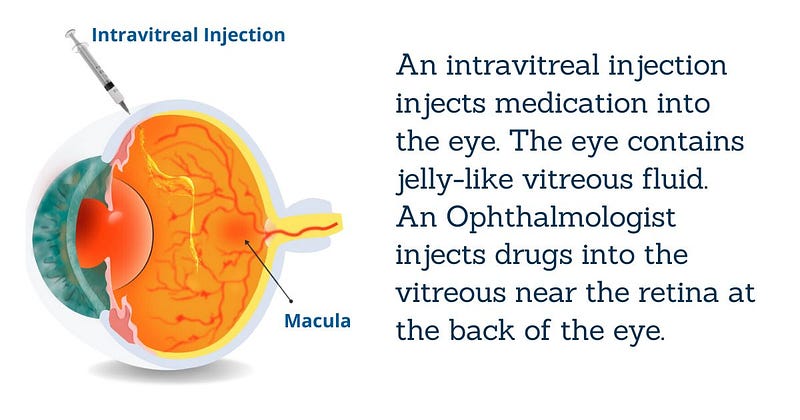
Think of it like having a superhero medicine that fights the bad stuff in your eye and helps your vision get clearer. It’s a big deal because it can work really well, and you won’t have to take lots of pills or have surgery.
So, intravitreal injections are like tiny superheroes for your eye, helping you see better when you face this eye problem.
Laser Therapy for Macular Edema: How It Works and Benefits
If you suffer from this eye problem, There could be tiny blood vessels or other structures within your eye that can cause problems and are making your vision blurred. The goal of laser therapy is to identify these troublesome areas and then gently destroy the area with precisely focused lights.
It’s like having a small repair team within your eye, utilizing laser beams to fix parts that are the cause of the issue. The greatest part is that you’ll never feel anything as this takes place.
The treatment of lasers can be described as having an eye doctor superhero that uses tiny beams light to treat the issues that make your vision blurred, assisting you to see clearly.
Macular Edema in Children: Causes, Diagnosis, and Care
Macular Edema in children indicates an extra amount of fluid within certain portions of their macula, creating pockets of moisture in unexpected places and leading to blurry vision as though looking through an opaque window.

At times, blurry vision can be caused by other factors within the body such as diabetes or other health concerns; Our eye doctors can quickly pinpoint the source and work towards solving it using treatments like shots, eye drops or lasers (don’t worry: these methods are completely safe!).
Importantly, whenever a parent/guardian notices difficulties with reading or seeing in their children, it’s best to visit an eye specialist immediately. They will be able to assess what’s happening and restore clear vision by improving it with appropriate treatment plans.
Conclusion:
Understanding the reasons, symptoms, diagnoses treatments and strategies, you can take preventive measures to protect your eyesight. If you face any problem in your eyes, you must go to an ophthalmologist immediately.
Comments
Post a Comment